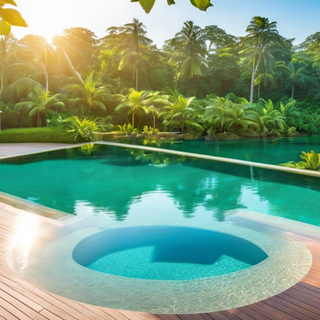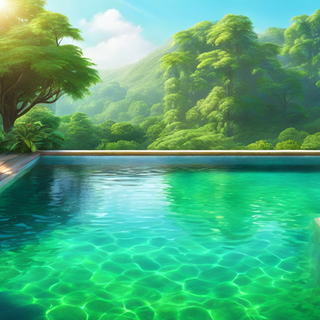The Solar Pool Ionizer produces ionization in your pool which kills algae and also prevents it from growing in the future. However, it will take a week of sunny days to get enough ions in the pool to stop the growth of new algae. What the product does NOT do (no product does) is actually remove the algae from your pool. This has to be done by quickly killing the algae and then filtering it out of the pool. This can be done in a couple of days if following the right steps.
- Manual Vacuuming is the Best Vacuuming
Automatic or robotic pool cleaners aren’t well suited to cleaning algae. Ideally, you’ll manually vacuum directly to waste, bypassing your filter and preventing recirculation of your contaminated water. When you vacuum your pool manually, pay special attention to areas with algae.
- Brush the Heck Outta That Pool
Scrubbing the algae off your pool walls lets your sanitizer get deeper into the remaining algae. It also stirs up the sediment you’ve brushed off so it can be killed and filtered out.
Using a stiff pool brush on a pole, brush the walls and floor of your pool. Pay special attention to corners and shady areas where algae is usually worst. As you go, your water will become cloudy, obstructing your view, so get those tough spots first.
- Test and Balance the Water
Use test strips or liquid kit to test your alkalinity and pH. Balancing your water chemistry now, ensures your sanitizer will be effective against the algae. High pH or low alkalinity will especially inhibit pool shock.
- Shock Treatment Can be a Good Thing
More resistant types of algae require more aggressive treatment, so if the infection is heavy, you’ll need more pool shock.
Even if you don’t normally use chlorine shock, for this purpose, it’s best to use calcium hypochlorite shock - and lots of it. Follow the package instructions to determine the dose for your pool size, then multiply that by two, three, or four depending on which type of algae you’ve got.
- Green Algae: Shock x2
- Yellow or Dark Green Algae: Shock x3
- Black Algae: Shock x4
Don’t use stabilized chlorine to shock your pool. You’ll end up with too much cyanuric acid, which inhibits sanitizer, and can lead you right back to algae in your pool, or other, worse problems.
Tip: Put your cleaning equipment in the shallow end while you shock your pool so your tools will also be sanitized.
Important: Remember to shock your pool at dusk or night. If you shock during the day, the sun will eat up most of the chlorine before it has a chance to kill the algae.
- Filter That Nasty Algae Out
When your shock treatment kills the algae, it’ll turn your water a cloudy blue. Run your filter continuously until the water clears up. You may add clarifier to speed up the process. Be sure to check whether you need to top off your water before turning on the pump.
- Clean Your Filter - Often
The last thing you want is a filter full of particles slowly filling your pool back up with microscopic algae. Deep clean your filter by soaking it in diluted muriatic acid, or simply replace it. If you want to clean out the algae from your pool quickly, I suggest cleaning the filter multiple times the first day that you sanitize the pool.
- Test Your Water Again
You may use your usual test methods or run a water sample to your local pool store for analysis. You want to be sure your water chemistry is balanced and your chlorine level is back to normal before anyone gets back into the water.
Finally
After a couple days, your pool should be looking good and balanced. The pool Ionizer should have been in the pool already and be producing enough ions to prevent any new algae growth. After a week, check the copper anode by unscrewing the basket from the bottom of the unit. The copper should be slowly corroding and turned a blueish/green color. This means it is working! Note: even if copper levels are low, if the copper is corroding it is working and you should have plenty of ions in the pool to prevent future algae growth. If it has not changed colors, you should reach out to us immediately so we can ship you a new unit.
See our instructions section for how to clean the copper. Good luck!



